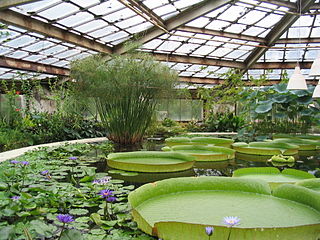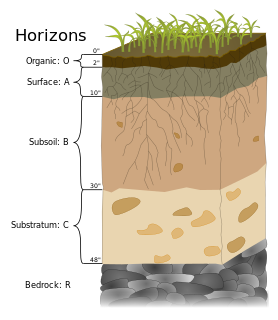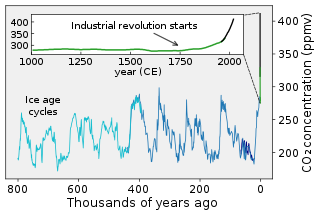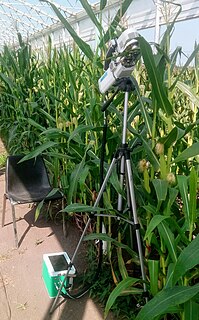
Carbon dioxide (chemical formula CO2) is a chemical compound occurring as a colorless gas with a density about 53% higher than that of dry air. Carbon dioxide molecules consist of a carbon atom covalently double bonded to two oxygen atoms. It occurs naturally in Earth's atmosphere as a trace gas. The current concentration is about 0.04% (417 ppm) by volume, having risen from pre-industrial levels of 280 ppm. In water it forms an acidic solution due to the formation of carbonic acid (H2CO3). Natural sources include volcanoes, forest fires, hot springs, geysers, and it is freed from carbonate rocks by dissolution in water and acids. Because carbon dioxide is soluble in water, it occurs naturally in groundwater, rivers and lakes, ice caps, glaciers and seawater. It is present in deposits of petroleum and natural gas. Carbon dioxide has a sharp and acidic odor and generates the taste of soda water in the mouth, but at normally encountered concentrations it is odorless.

In botany, a stoma, also called a stomate, is a pore found in the epidermis of leaves, stems, and other organs, that controls the rate of gas exchange. The pore is bordered by a pair of specialized parenchyma cells known as guard cells that are responsible for regulating the size of the stomatal opening.

A greenhouse is a structure with walls and roof made chiefly of transparent material, such as glass, in which plants requiring regulated climatic conditions are grown. These structures range in size from small sheds to industrial-sized buildings. A miniature greenhouse is known as a cold frame. The interior of a greenhouse exposed to sunlight becomes significantly warmer than the external temperature, protecting its contents in cold weather.

Plant nutrition is the study of the chemical elements and compounds necessary for plant growth and reproduction, plant metabolism and their external supply. In its absence the plant is unable to complete a normal life cycle, or that the element is part of some essential plant constituent or metabolite. This is in accordance with Justus von Liebig’s law of the minimum. The total essential plant nutrients include seventeen different elements: carbon, oxygen and hydrogen which are absorbed from the air, whereas other nutrients including nitrogen are typically obtained from the soil.

Photorespiration (also known as the oxidative photosynthetic carbon cycle or C2 cycle) refers to a process in plant metabolism where the enzyme RuBisCO oxygenates RuBP, wasting some of the energy produced by photosynthesis. The desired reaction is the addition of carbon dioxide to RuBP (carboxylation), a key step in the Calvin–Benson cycle, but approximately 25% of reactions by RuBisCO instead add oxygen to RuBP (oxygenation), creating a product that cannot be used within the Calvin–Benson cycle. This process lowers the efficiency of photosynthesis, potentially lowering photosynthetic output by 25% in C3 plants. Photorespiration involves a complex network of enzyme reactions that exchange metabolites between chloroplasts, leaf peroxisomes and mitochondria.
Sherwood B. Idso is the president of the Center for the Study of Carbon Dioxide and Global Change, which rejects the scientific consensus on climate change. Previously he was a Research Physicist with the U.S. Department of Agriculture's Agricultural Research Service at the U.S. Water Conservation Laboratory in Phoenix, Arizona, where he worked since June 1967. He was also closely associated with Arizona State University over most of this period, serving as an Adjunct Professor in the Departments of Geology, Geography, and Botany and Microbiology. His two sons, Craig and Keith, are, respectively, the founder and vice president of the Center for the Study of Carbon Dioxide and Global Change.

Soil fertility refers to the ability of soil to sustain agricultural plant growth, i.e. to provide plant habitat and result in sustained and consistent yields of high quality. A fertile soil has the following properties:
Theoretical production ecology tries to quantitatively study the growth of crops. The plant is treated as a kind of biological factory, which processes light, carbon dioxide, water, and nutrients into harvestable parts. Main parameters kept into consideration are temperature, sunlight, standing crop biomass, plant production distribution, nutrient and water supply.
Ecophysiology, environmental physiology or physiological ecology is a biological discipline that studies the response of an organism's physiology to environmental conditions. It is closely related to comparative physiology and evolutionary physiology. Ernst Haeckel's coinage bionomy is sometimes employed as a synonym.

Carbon dioxide is an important trace gas in Earth's atmosphere. It is an integral part of the carbon cycle, a biogeochemical cycle in which carbon is exchanged between the Earth's oceans, soil, rocks and the biosphere. Plants and other photoautotrophs use solar energy to produce carbohydrate from atmospheric carbon dioxide and water by photosynthesis. Almost all other organisms depend on carbohydrate derived from photosynthesis as their primary source of energy and carbon compounds. CO2 absorbs and emits infrared radiation at wavelengths of 4.26 μm (2347 cm−1) and 14.99 μm (667 cm−1) and consequently is a greenhouse gas that plays a significant role in influencing Earth's surface temperature through the greenhouse effect.

Human impact on the nitrogen cycle is diverse. Agricultural and industrial nitrogen (N) inputs to the environment currently exceed inputs from natural N fixation. As a consequence of anthropogenic inputs, the global nitrogen cycle (Fig. 1) has been significantly altered over the past century. Global atmospheric nitrous oxide (N2O) mole fractions have increased from a pre-industrial value of ~270 nmol/mol to ~319 nmol/mol in 2005. Human activities account for over one-third of N2O emissions, most of which are due to the agricultural sector. This article is intended to give a brief review of the history of anthropogenic N inputs, and reported impacts of nitrogen inputs on selected terrestrial and aquatic ecosystems.

Soil respiration refers to the production of carbon dioxide when soil organisms respire. This includes respiration of plant roots, the rhizosphere, microbes and fauna.
William H. Schlesinger is a biogeochemist and the retired president of the Cary Institute of Ecosystem Studies, an independent not-for-profit environmental research organization in Millbrook, New York. He assumed that position after 27 years on the faculty of Duke University, where he served as the Dean of the Nicholas School of the Environment and Earth Sciences and James B. Duke Professor of Biogeochemistry.

Photosynthesis systems are electronic scientific instruments designed for non-destructive measurement of photosynthetic rates in the field. Photosynthesis systems are commonly used in agronomic and environmental research, as well as studies of the global carbon cycle.
Biomass partitioning is the process by which plants divide their energy among their leaves, stems, roots, and reproductive parts. These four main components of the plant have important morphological roles: leaves take in CO2 and energy from the sun to create carbon compounds, stems grow above competitors to reach sunlight, roots absorb water and mineral nutrients from the soil while anchoring the plant, and reproductive parts facilitate the continuation of species. Plants partition biomass in response to limits or excesses in resources like sunlight, carbon dioxide, mineral nutrients, and water and growth is regulated by a constant balance between the partitioning of biomass between plant parts. An equilibrium between root and shoot growth occurs because roots need carbon compounds from photosynthesis in the shoot and shoots need nitrogen absorbed from the soil by roots. Allocation of biomass is put towards the limit to growth; a limit below ground will focus biomass to the roots and a limit above ground will favor more growth in the shoot.

The effects of climate change on agriculture can result in lower crop yields and nutritional quality due to for example drought, heat waves and flooding as well as increases in pests and plant diseases. The effects are unevenly distributed across the world and are caused by changes in temperature, precipitation and atmospheric carbon dioxide levels due to global climate change. In 2019, millions already suffer from food insecurity due to climate change and predicted decline in global crop production of 2% - 6% by decade. It has been predicted in 2019 that food prices will rise by 80% by 2050 which will likely lead to food insecurity, disproportionally affecting poorer communities. A 2021 study estimates that the severity of heatwave and drought impacts on crop production tripled over the last 50 years in Europe – from losses of 2.2% during 1964–1990 to losses of 7.3% in 1991–2015.
The CO2 fertilization effect or carbon fertilization effect causes an increased rate of photosynthesis while limiting leaf transpiration in plants. Both processes result from increased levels of atmospheric carbon dioxide (CO2). Earth System Models (ESMs), Land System Models (LSMs), and Dynamic Global Vegetation Models (DGVMs) are used to investigate and interpret vegetation trends related to increasing levels of atmospheric CO2. However, the ecosystem processes associated with the CO2 fertilization effect remain uncertain and therefore are challenging to model.

Ocean storage of carbon dioxide (CO2) is a method of carbon sequestration. The concept of storing carbon dioxide in the ocean was first proposed by Italian physicist Cesare Marchetti in his 1976 paper "On Geoengineering and the carbon dioxide problem." Since then, the concept of sequestering atmospheric carbon dioxide in the world's oceans has been investigated by scientists, engineers, and environmental activists. 39,000 GtC (gigatonnes of carbon) currently reside in the oceans while only 750 GtC are in the atmosphere.

Reinhart Jan Maria Ceulemans is an emeritus professor of Ecology and previous director of the Research Center of Excellence PLECO of the University of Antwerp. He has been vice-dean of the Faculty of Sciences at the University of Antwerp, and was a visiting professor at the University of Washington, Seattle, USA (1987-1988), at the Université Paris-Sud XI, Orsay and at the University of Ghent. He officially retired in October 2019 and is now a visiting professor at the University of Antwerp (Belgium), a researcher at CzechGlobe Academy of Sciences in Brno and an international consultant to the Slovenian Forestry Institute.

Elizabeth Anna Ainsworth is an American molecular biologist currently employed by the United States Department of Agriculture (USDA) Agricultural Research Service (ARS). She also is an Adjunct Professor of the University of Illinois at Urbana-Champaign (UIUC), a Fellow of the American Association for the Advancement of Science (AAAS) and was awarded the 2018 Crop Science Society of America Presidential Award. She is known for her work concerning the effects of specific atmospheric pollutants, including ozone and carbon dioxide, on the productivity of selected major crops such as corn and soybeans.














